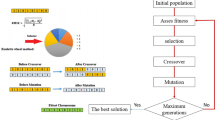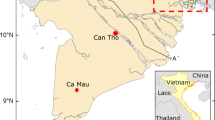Abstract
This investigation aimed to examine the load carrying capacity of model piles embedded in sandy soil and to develop a predictive model to simulate pile settlement using a new artificial neural network (ANN) approach. A series of experimental pile load tests were carried out on model concrete piles, comprised of three piles with slenderness ratios of 12, 17 and 25. This was to provide an initial dataset to establish the ANN model, in attempt at making current, in situ pile-load test methods unnecessary. Evolutionary Levenberg–Marquardt (LM) MATLAB algorithms, enhanced by T-tests and F-tests, were developed and applied in this process. The model piles were embedded in a calibration chamber in three densities of sand; loose, medium and dense. According to the statistical analysis and the relative importance study, pile lengths, applied load, pile flexural rigidity, pile aspects ratio, and sand-pile friction angle were found to play a key role in pile settlement at different contribution levels, following the order: P > δ > lc/d > lc > EA. The results revealed that the optimum model of the LM training algorithm can be used to characterize pile settlement with good degree of accuracy. There was also close agreement between the experimental and predicted data with a root mean square error, (RMSE) and correlation coefficient (R) of 0.0025192 and 0.988, respectively.











Similar content being viewed by others
References
Abdellatif M, Atherton W, Alkhaddar R, Osman Y (2015) Flood risk assessment for urban water system in a changing climate using artificial neural network. J Nat Hazards 79:1059–1077
Akdag CT, Özden G (2013) Nonlinear behavior of reinforced concrete (RC) and steel fiber added RC (WS-SFRC) model piles in medium dense sand. Constr Build Mater 48:464–472
Alizadeh B, Najjari S, Kadkhodaie-Ilkhchi A (2012) Artificial neural network modeling and cluster analysis for organic facies and burial history estimation using well log data: A case study of the South Pars Gas Field, Persian Gulf, Iran. J Comput Geosci 45:261–269
Alkroosh IS, Bahadori M, Nikraz H, Bahadori A (2015) Regressive approach for predicting bearing capacity of bored piles from cone penetration test data. J Rock Mech Geotech Eng 7:584–592
American Society for Testing and Materials ASTM (2013) ASTM D1143/D1143 M-07 standard test methods for deep foundations under static axial compressive load. American Society for Testing and Materials ASTM, West Conshohocken
Bashar T (2013) Pipe pilesetup: database and prediction model using artificial neural network. Soils Found 53(4):607–615
BSI (BS EN 8004:1986) Code of practice for foundations. BSI, London
Das BM (2015) Principles of foundation engineering. United State of America: Global Engineering, Eighth edn. Nelson Education LTD, Scarborough
Feng Q, Kong Q, Song G (2016) Damage detection of concrete piles subject to typical damage types based on stress wave measurement using embedded smart aggregates transducers. Measurement 88:345–352
Field A (2008) Multiple regression using SPSS. Res Methods Psychol C8057:1–11
Hagan MT, Demuth HB, Beale MH, Jesús OD (1996) Neural network design, 2nd edn. PWS Publishing Co., Boston
Hashim KS, Shaw A, Al Khaddar R, Pedrola MO, Phipps D (2017a) Defluoridation of drinking water using a new flow column electrocoagulation reactor (FCER)—experimental, statistical, and economic approach. J Environ Manag 197:80–88
Hashim KS, Shaw A, Al Khaddar R, Pedrola MO, Phipps D (2017b) Energy efficient electrocoagulation using a new flow column reactorto remove nitrate from drinking water—experimental, statistical, and economic approach. J Environ Manag 196:224–233
Hashim KS, Shaw A, Al Khaddar R, Pedrola MO, Phipps D (2017c) Iron removal, energy consumption and operating cost of electrocoagulation of drinking water using a new flow column reactor. J Environ Manag 189:98–108
Jaeel AJ, Al-wared AI, Ismail ZZ (2016) Prediction of sustainable electricity generation in microbial fuel cell by neural network: effect of anode angle with respect to flow direction. J Electroanal Chem 767:56–62
Jebur AA, AthertoN W, Alkhadar RM, Loffil E (2017a) Nonlinear analysis of single model piles subjected to lateral load in sloping ground. Proc Eng 196:52–59
Jebur AA, Atherton W, Alkhadar RM, Loffill E (2017b) Piles in sandy soil: a numerical study and experimental validation. Proc Eng 196:60–67
Jeong D-I, Kim Y-O (2005) Rainfall-runoff models using artificial neural networks for ensemble stream flow prediction. Hydrol Process 19(19):3819–3835
Loria RAF, Orellana F, Minardi A, Fürbringer J-M, Laloui L (2015) Predicting the axial capacity of piles in sand. Comput Geotech 69:485–495
Madhusudan RK, Ayothiraman R (2015) Experimental studies on behavior of single pile under combined uplift and lateral loading. J Geotech Geoenviron Eng 141:1–10
Majdi M, Beiki M (2010) Evolving neural network using a genetic algorithm for predicting the deformation modulus of rock masses. Int J Rock Mech Mining Sci 47:246–253
Majeed AH, Mahmood KR, Jebur AA (2013) Simulation of hyperbolic stress-strain parameters of soils using artificial neural networks. In: 23rd International conference on geotechnical engineering, Hammamet, Tunisia, pp 105–115
Masters T (1993) Practical neural network recipes in C++. Academic, San Diego
Momeni E, Nazir A, Armaghani DJ, Maizir H (2014) Prediction of pile bearing capacity using a hybrid genetic algorithm-based ANN. Measurement 57:122–131
Mullapudi R, Ayoub A (2010) Nonlinear finite element modeling of beams on two parameter foundations. Comput Geotech 37:334–342
Naghibi F, Fenton GA, Griffiths DV (2014) Prediction of pile settlement in an elastic soil. Comput Geotech 60:29–32
Nejad FP, Jaksa MB (2017) Load-settlement behavior modeling of single piles using artificial neural networks and CPT data. J Comput Geotech 89:9–12
Nejad FP, Jaksa MB, Kakhi M, McCabe BA (2009) Prediction of pile settlement using artificial neural networks based on standard penetration test data. J Comput Geotech 36(7):1125–1133
Nguyen-Truong HT, Le HM (2015) An implementation of the Levenberg–Marquardt algorithm for simultaneous-energy-gradient fitting using two-layer feed forward neural networks. Chem Phys Lett 629:40–45
Nunez I, Hoadley P, Randolph M, Hulett J (1988) Driving and tension loading of piles in sand on a centrifuge. In: Corte JF (ed) Centrifuge’ 88: proceedings international conference centrifuge. A.A. Balkema, Paris (Rotterdam), pp 353–362
Pallant J (2005) SPSS survival manual. Allen & Unwin, Australia
Remaud D (1999) Pieux Sous Charges Latérales: Etude Expérimentale De L’effet De Groupe. PhD thesis. Université de Nantes; French
Rumelhart DE, Hinton GE, Williams RJ (1986) Learning internal representation by error propagation. In: Rumelhart DE, McClelland JL (eds) Parallel distributed processing. MIT Press, Cambridge, pp 318–362
Schmidhuber J (2015) Deep learning in neural networks: an overview. Neural Netw 61:85–117
Shahin MA (2013) Artificial intelligence for modeling load-settlement response of axially loaded (steel) driven piles. In: Proceedings of the 18th international conference on soil mechanics and geotechnical engineering, Paris, pp 797–800
Shahin MA (2014) Load–settlement modeling of axially loaded steel driven piles using CPT-based recurrent neural networks. J Soils Found 54(3):515–522
Shahin MA (2016) State-of-the-art review of some artificial intelligence applications in pile foundations. Geosci Front J 7(1):33–44
Shahin MA, Jaksa MB (2005) Neural network prediction of pullout capacity of marquee ground anchors. J Comput Geotech 32:153–163
Shahin MA, Maier HR, Jaksa MB (2002) Predicting settlements of shallow foundations using artificial neural networks. J Geotech Geoenviron Eng ASCE 128(9):785–793
Tabachnick BG, Fidell LS (2013) Using multivariate statistics, 6th edn. Allyn and Bacon, Boston
Taylor RN (1995) Geotechnical centrifuge technology, 1st edn. Chapman & Hall, London
Tomlinson MJ (2014) Pile design and construction, 6th edn. E & FN Spon, London
Trigo R (2000) Improving metrological downscaling methods with artificial neural network models. Dissertation, University of East Anglia
Tschuchnigg F, Schweiger HF (2015) The embedded pile concept—verification of an efficient tool for modelling complex deep foundations. Comput Geotech 63:244–254
Unsever YS, Matsumoto T, Özkan MY (2015) Numerical analyses of load tests on model foundations in dry sand. Comput Geotech 63:255–266
Walfish S (2006) A review of statistical outlier methods. Pharm Technol 30:82–86
Xu L-Y, Cai F, Wang G-X, Ugai K (2013) Nonlinear analysis of laterally loaded single piles in sand using modified strain wedge model. Comput Geotech 51:60–71
Yadav AK, Malik H, Chandel SS (2014) Selection of most relevant input parameters using WEKA for artificial neural network based solar radiation prediction models. Renew Sustain Energy Rev 31:509–519
Young HD, Freedman RA (2000) University physics, 10th edn. Addison Wesley Longman, San Francisco
Acknowledgements
The first author would like to show his gratitude to Dr. William Atherton and Prof. Rafid Al Khaddar for their guidance and to the technical staff from Liverpool John Moores University, UK, who provided insight and expertise for the current study. The authors would like to acknowledge the Iraqi Ministry of Higher Education and Scientific Research and Wasit University for the grant provided to carry out this research.
Author information
Authors and Affiliations
Corresponding author
Rights and permissions
About this article
Cite this article
Jebur, A.A., Atherton, W., Al Khaddar, R.M. et al. Settlement Prediction of Model Piles Embedded in Sandy Soil Using the Levenberg–Marquardt (LM) Training Algorithm. Geotech Geol Eng 36, 2893–2906 (2018). https://doi.org/10.1007/s10706-018-0511-1
Received:
Accepted:
Published:
Issue Date:
DOI: https://doi.org/10.1007/s10706-018-0511-1




